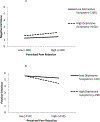Depressive Symptoms Amplify Emotional Reactivity to Daily Perceptions of Peer Rejection in Adolescence
- PMID: 31620972
- PMCID: PMC6959480
- DOI: 10.1007/s10964-019-01146-4
Depressive Symptoms Amplify Emotional Reactivity to Daily Perceptions of Peer Rejection in Adolescence
Abstract
During adolescence, interpersonal stressors such as peer rejection pose challenges to emotion regulation. Yet, very little is known about how these transactional processes unfold in adolescents' daily lives. This study investigated adolescents' (a) emotional reactivity to daily perceptions of peer rejection, which concerns concurrent changes in negative and positive emotions, and (b) emotional recovery from daily perceptions of peer rejection, which concerns subsequent changes in negative and positive emotions. Because depressive symptoms can compromise effectiveness of emotion regulation, it was investigated as a moderator for emotional reactivity and recovery to daily perceptions of peer rejection. The sample consisted of 303 adolescents (59% girls; Mage = 14.20, SD = 0.54; range 13-16 years) who reported depressive symptoms at baseline and completed ecological momentary assessments of emotions and perceived peer rejection at nine random time-points per day for six consecutive days. Results from multi-level modeling analyses showed that perceived peer rejection was related to emotional reactivity (i.e., higher levels of negative emotions and lower levels of positive emotions). This effect was stronger for those with higher depressive symptoms. For emotional recovery, perceived peer rejection had lasting effects on adolescents' negative emotions, but was not related to positive emotions. Depressive symptoms did not moderate effects of perceived peer rejection on emotional recovery. This study provides a more nuanced understanding of how depressive symptoms amplify the emotional impact of perceived peer rejection in adolescents' day-to-day lives.
Keywords: Adolescents; Depressive Symptoms; Ecological momentary assessment; Emotional reactivity and recovery; Negative and positive emotions; Peer rejection.
Figures

References
-
- Coie JD, Dodge KA & Coppotelli H (1982). Dimensions and types of social status: a cross-age perspective. Developmental Psychology, 18, 557–570. 10.1037/0012-1649.18.4.557 - DOI
MeSH terms
Grants and funding
LinkOut - more resources
Full Text Sources
Medical

